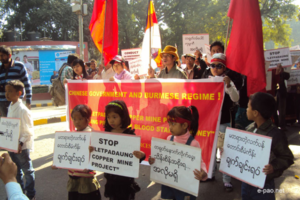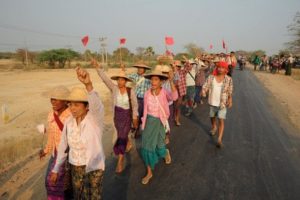As one of China’s three largest investment projects in Myanmar, the Letpadaung copper mine is a joint venture between Myanmar’s military-owned conglomerate, the Union of Myanmar Economic Holdings Limited (UMEHL), and Wanbao Mining, a subsidiary of China’s state-owned armed manufacturer China Ordnance Industries Group Corporation Limited (NORINCO).[1] This mouthful of an introduction reflects a complex and fractured landscape of Chinese and Burmese actors involved in the Letpadaung copper mine, ranging from state-backed multinational corporations to disenfranchised villagers and protestors.[2]
On 3 June 2010, then-Chinese Premier Wen Jiabao visited Myanmar to finalize and sign a USD 1.1 billion contract with Myanmar’s former military government, one year before Myanmar’s seminal democratic elections in 2011.[3] Geographically located in Sagaing region, the Letpadaung copper mine in western Myanmar was originally part of the Monywa copper concession, one of the largest copper deposits in Southeast Asia.[4] However, the Letpadaung project was suspended in November 2012 due to widespread local resistance in Myanmar.[5] At the height of social unrest between September 2012 and January 2013, near-daily demonstrations protested farmland confiscation,[6] forced expulsion,[7] insufficient compensation,[8] inadequate environmental protection,[9] and the demolition of a revered Buddhist temple.[10] These intertwined grievances collectively stem from a lack of active community consultation; Burmese villagers were treated as passive participants who were notified of already-made decisions.[11]
Although the Letpadaung copper mine project was renegotiated in 2013 and resumed in 2014, the unfavorable outcomes of renegotiation and other suspended Chinese infrastructure projects soured China’s bilateral ties with Myanmar starting in late 2011.[12] However, beyond the inter-governmental level, the Letpadaung copper mine is also entangled in a wider fabric of anti-Chinese sentiments weaved by Myanmar’s public opinion.[13] Embedded in and exacerbated by dissatisfaction with the Burmese state, negative public perceptions in Myanmar reflect China’s soft power deficit in the overseas destinations of its financial capital. For example, Chinese investment is often characterized by a willingness to inherit projects abandoned by Western companies due to environmental and social concerns.[14] In the present case, China’s Wanbao Mining took over the Letpadaung mine after Ivanhoe Mines Limited from Canada withdrew from the project. [15] Furthermore, joint ventures with China are conventionally imagined as deficient in profit-sharing with the host country and local communities.[16]
Anti-Chinese animosity in Myanmar also reflects broader anxieties about China-driven globalization and China’s seemingly hegemonic vision of development.[17] For instance, in India, one of Myanmar’s neighbor and active investors, press coverage widely construed the suspension of Letpadaung as a sign that the Burmese leadership will seek to restrain China’s economic dominance.[18] In response to disapproving media discourses, Wanbao Mining released a ten-minute video in April 2016 entitled “A New Dawn,” which details an explanation of Letpadaung’s suspension and emphasizes the need for “social acceptance” of Chinese projects.[19]
Domestically, the Letpadaung copper mine also represents an important moment in the development of Myanmar’s human rights discourses. In 2011-2012, as Myanmar transitioned into a fragile democracy, the Letpadaung project was a test of civil freedoms and an experiment of social latitude. In a country where 70% of the population is dependent on agriculture, the Letpadaung protests tested the boundaries of ‘permitted’ localized struggles for land, labor and environmental rights.[20]
Manifestations of this domestic negotiation are two-fold. On one hand, the Burmese police’s crackdown on protestors called into question public understandings of one’s ‘rights’ at the intersection of the military’s powerful economic interests and nascent forces of democratization.[21] In November 2012 and December 2014, the police fired white phosphorous incendiary munition at protestors, causing numerous injuries and one death.[22] In this regard, Burmese citizens struggled to reconcile conflicting images of a new electoral and democratic order in 2011, versus new state-perpetuated crimes that resemble the era of dictatorship under Burma’s former military junta.[23] On the other hand, many civil society groups were emboldened by the Burmese government’s investigation of Letpadaung and by its contractual renegotiations.[24] The Burmese state’s response hinted at its subtle acquiescence towards grassroots resistance against damaging foreign and Chinese investment.[25]
As a government with disproportionately high spending on extractive and resource industries,[26] the Burmese state is confronted with a  challenging balance between local demands from protesting communities and the military, versus diplomatic considerations of attracting foreign investors and avoiding friction with a powerful neighbor.[27] Therefore, the Letpadaung case not only reflects negotiations of rights between Burmese citizens and the state; it also elucidates processes of negotiation between seemingly profit-driven actors. Notably, between Wanbao and UMEHL, the responsibility of community consultation is also negotiated. Unlike most mining operations, where the mining corporate actor directly engages indigenous stakeholders, the Letpadaung Production Sharing Agreement specifies that the Burmese state is responsible for community consultation and the UMEHL oversees land acquisition compensation and resettlement.[28] In other words, Wanbao was technically being held accountable and condemned for failing to fulfil a responsibility it did not consent to, at least in terms of formal contractual obligations. However, in light of rampant protests, Wanbao chose to swallow a 41% loss of profit and accommodate higher socio-environmental standards, rather than terminate the project.[29] This willingness to concede in exchange for community consent is mirrored by UMEHL, which suffered from an even more significant economic loss.[30]
challenging balance between local demands from protesting communities and the military, versus diplomatic considerations of attracting foreign investors and avoiding friction with a powerful neighbor.[27] Therefore, the Letpadaung case not only reflects negotiations of rights between Burmese citizens and the state; it also elucidates processes of negotiation between seemingly profit-driven actors. Notably, between Wanbao and UMEHL, the responsibility of community consultation is also negotiated. Unlike most mining operations, where the mining corporate actor directly engages indigenous stakeholders, the Letpadaung Production Sharing Agreement specifies that the Burmese state is responsible for community consultation and the UMEHL oversees land acquisition compensation and resettlement.[28] In other words, Wanbao was technically being held accountable and condemned for failing to fulfil a responsibility it did not consent to, at least in terms of formal contractual obligations. However, in light of rampant protests, Wanbao chose to swallow a 41% loss of profit and accommodate higher socio-environmental standards, rather than terminate the project.[29] This willingness to concede in exchange for community consent is mirrored by UMEHL, which suffered from an even more significant economic loss.[30]
Years after its revenue-sharing renegotiation, the Letpadaung project is now among the best performing and most effectively managed projects in Myanmar in terms of environmental and social impact assessment.[31] Although still far from perfect and admittedly motivated by a desire to address its negative public image, the Letpadaung copper mine is an important case study of frictions between China’s overseas extraction and the complex regulatory environments of its destinations. Before the physical material of copper even crosses the border, China’s developmental approach is questioned, negotiated and problematized by a myriad of community-based approaches and local reactions.[32] Thus, the Letpadaung copper mine offers valuable lessons learned about the emerging importance of corporate social responsibility policies to Chinese overseas investment, and the progression of this case offers potential prospects for cautious optimism in the future of China’s global economic presence.[33]
Bibliography
Andrews-Speed, Philip, Mingda Qiu, and Christopher Len. 2016. “Chinese Engagement in Southeast Asian Energy and Mineral Resources: Motivations and Outlook.” Eurasian Geography and Economics 57 (3): 316–42. https://doi.org/10.1080/15387216.2016.1211025.
Aung, Thiri Shwesin, Shengji Luan, and Sharon Condon. 2019. “Evaluation of the Environmental Impact Assessment (EIA) of Chinese EIA in Myanmar: Myitsone Dam, the Letpadaung Copper Mine and the Sino-Myanmar Oil and Gas Pipelines.” Impact Assessment and Project Appraisal 37 (1): 71–85. https://doi.org/10.1080/14615517.2018.1529948.
Bonnitcha, Jonathan. 2017. “International Investment Arbitration in Myanmar: Bounded Rationality, But Not as We Know It.” The Journal of World Investment & Trade 18 (5–6): 974–1000. https://doi.org/10.1163/22119000-12340068.
Engh, Sunniva. 2016. “India’s Myanmar Policy and the ‘Sino-Indian Great Game’” Asian Affairs 47 (1): 32–58. https://doi.org/10.1080/03068374.2015.1130307.
Gardiner, Nicholas J., John P. Sykes, Allan Trench, and Laurence J. Robb. 2015. “Tin Mining in Myanmar: Production and Potential.” Resources Policy 46: 219–33. https://doi.org/10.1016/j.resourpol.2015.10.002.
Ghoshal, Baladas. 2013. “Democratic Transition in Myanmar: Challenges Ahead.” India Quarterly 69 (2): 117–31. https://doi.org/10.1177/0974928413481882.
Holliday, Ian. 2014. “Addressing Myanmar’s Citizenship Crisis.” Journal of Contemporary Asia 44 (3): 404–21. https://doi.org/10.1080/00472336.2013.877957.
Len, Christopher. 2015. “China’s 21st Century Maritime Silk Road Initiative, Energy Security and SLOC Access.” Maritime Affairs: Journal of the National Maritime Foundation of India 11 (1): 1–18. https://doi.org/10.1080/09733159.2015.1025535.
Mark, SiuSue, and Youyi Zhang. 2017. “From Impediment to Adaptation: Chinese Investments in Myanmar’s New Regulatory Environment.” Journal of Current Southeast Asian Affairs 36 (2): 71–100. https://doi.org/10.1177/186810341703600203.
Mohan Malik, J. 2018. “Myanmar’s Role in China’s Maritime Silk Road Initiative.” Journal of Contemporary China 27 (111): 362–78. https://doi.org/10.1080/10670564.2018.1410969.
Myoe, Maung Aung. 2015. “Myanmar’s China Policy since 2011: Determinants and Directions.” Journal of Current Southeast Asian Affairs 34 (2): 21–54. https://doi.org/10.1177/186810341503400202.
Ping, Jonathan H. 2013. “China’s Relations with India’s Neighbours: From Threat Avoidance to Alternative Development Opportunity.” Asian Journal of Political Science 21 (1): 21–40. https://doi.org/10.1080/02185377.2013.793559.
Su, Xiaobo. 2016. “Repositioning Yunnan: Security and China’s Geoeconomic Engagement with Myanmar.” Area Development and Policy 1 (2): 178–94. https://doi.org/10.1080/23792949.2016.1197780.
Sun, Yun. 2013. “Chinese Investment in Myanmar: What Lies Ahead?” Stimson Center Great Powers and the Changing Myanmar (Issue Brief No. 1): 12.
Tang-Lee, Diane. 2016. “Corporate Social Responsibility (CSR) and Public Engagement for a Chinese State-Backed Mining Project in Myanmar – Challenges and Prospects.” Resources Policy 47 (March): 28–37. https://doi.org/10.1016/j.resourpol.2015.11.003.
Zerrouk, Emel, and Andreas Neef. 2014. “The Media Discourse of Land Grabbing and Resistance During Myanmar’s Legal Reformation: The Monywa Copper Mine.” Law and Development Review 7 (2): 275–312. https://doi.org/10.1515/ldr-2014-0008.
[1] Sun, 1, 5; Myoe, 29; Ping, 36; Len, 12.
[2] Malik, 237, 364; Ping, 36.
[3] Myoe, 29; Sun, 5; Ghoshal, 128; Bonnitcha, 985; Tang-Lee, 31; Andrews-Speed, Qiu, and Len, 335.
[4] Myoe, 38; Gardiner, Sykes, Trench and Robb, 229.
[5] Malik, 237; Sun, 1, 5.
[6] Myoe, 39; Mark and Zhang, 81; Len, 12; Tang-Lee, 31.
[7] Zerrouk and Neef, 302; Gardiner, Sykes, Trench and Robb, 229.
[8] Andrews-Speed, Qiu, and Len, 335; Myoe, 39.
[9] Myoe, 29; Sun, 4; Andrews-Speed, Qiu, and Len, 329, 335; Len, 12; Mark and Zhang, 81.
[10] Myoe, 39; Mark and Zhang, 81; Zerrouk and Neef, 227.
[11] Tang-Lee, 31.
[12] Myoe, 46.
[13] Ibid, 29; Ghoshal, 128.
[14] Andrews-Speed, Qiu, and Len, 335.
[15] Andrews-Speed, Qiu, and Len, 335.
[16] Sun, 4, 5.
[17] Su, 183.
[18] Engh, 49.
[19] Mark and Zhang, 89.
[20] Zerrouk and Neef, 276.
[21] Holliday, 408.
[22] Len, 12; Gardiner, Sykes, Trench and Robb, 229.
[23] Ghoshal, 128; Zerrouk and Neef, 277.
[24] Mark and Zhang, 82.
[25] Ibid, 82.
[26] Holliday, 408.
[27] Sun, 5; Ghoshal, 128.
[28] Tang-Lee, 32.
[29] Sun, 6.
[30] Ibid, 4.
[31] Aung, Luan, and Condon, 77, 83; Mark and Zhang, 90.
[32] Su, 183.
[33] Mark and Zhang, 90.
Contributor: Angela Hou